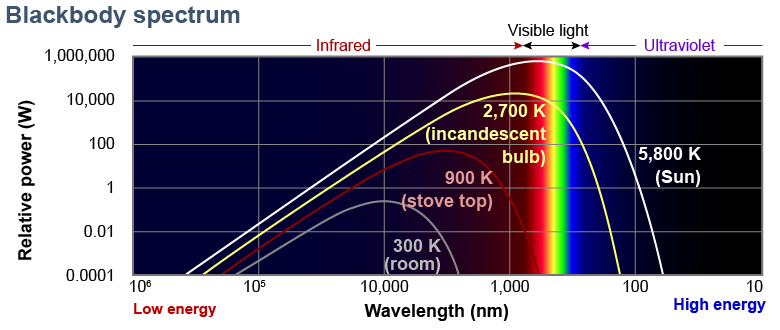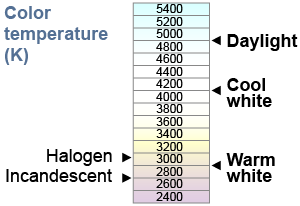|
An object appears perfectly black when it absorbs all light that falls on its surface, reflecting nothing. If all radiation is absorbed, then any radiation coming off the surface can only be thermal radiation. In physics, a perfect blackbody is a surface that reflects nothing and emits pure thermal radiation. That does not mean an object looks black! The Sun is a pretty good blackbody and so is the white-hot filament of an incandescent light bulb. For both the Sun and the filament, all light coming from the surface is thermal radiation, and none is reflected from other sources. 
|
Thermal radiation always includes a range of different wavelengths from low-energy infrared to high-energy ultraviolet. In 1900, German physicist Max Planck deduced the spectrum of blackbody radiation, which many feel is the first experimental success of the new quantum theory. The diagram below shows the blackbody spectrum for several different temperatures. 
|

|
An incandescent bulb filament, at 2,700 K, includes the whole range of visible light. Most of the power emitted by an incandescent bulb, however, is at infrared wavelengths, transferring heat instead of providing visible light. Incandescent light bulbs are quite inefficient, emitting less than 10% of their energy in visible light. The Sun has a surface temperature of 5,800 K. From the 5,800 K blackbody curve you can see that the solar spectrum produces visible light, infrared light, and quite a lot of potentially harmful, high-energy, ultraviolet light as well. 
|
 Compact-fluorescent bulbs come in soft white, cool white, and daylight color temperatures. Each type corresponds to a temperature in kelvins. The bulb has been designed to give off light in which the relative intensities of red, green, and blue light are balanced according to the blackbody spectrum for the bulb’s color temperature. A cool white bulb at 4,100 K has more blue in its light than a warm white at 2,900 K.
Compact-fluorescent bulbs come in soft white, cool white, and daylight color temperatures. Each type corresponds to a temperature in kelvins. The bulb has been designed to give off light in which the relative intensities of red, green, and blue light are balanced according to the blackbody spectrum for the bulb’s color temperature. A cool white bulb at 4,100 K has more blue in its light than a warm white at 2,900 K. 
|
What is true about a “black” object at a temperature of 700 K? - The object emits no thermal radiation.
- The object emits light that looks dull red in color.
- The object emits a spectrum of thermal radiation including some blue light.
- The object has an emissivity much greater than one.
 |
Choice b is the correct answer because the blackbody spectrum for 700 K will be between the graph for 900 K and the one for room temperature. Objects typically start to glow a dull red at around this temperature. 
|
| |
|

